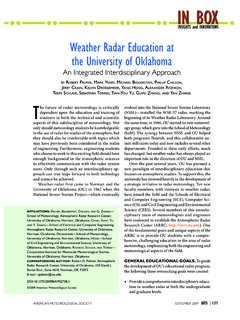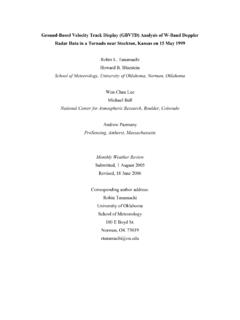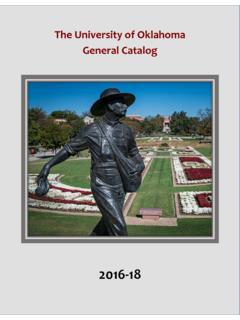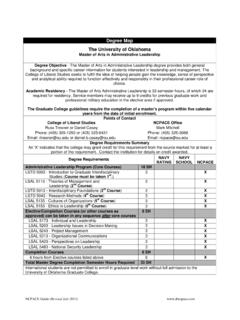Transcription of UNIVERSITY OF OKLAHOMA - Defense Technical …
1 4-4] DECISION PROCESSES LABORATORYUNIVERSITY OF OKLAHOMAOFFICE OF NAVAL RESEARCHCONTRACT NUMBER NR1-ZREPRODUCTIONJN WHOLE OR-IN.,PART IS-PERMITTED FOR ANY-PURPOSEtOFTHEUNITED STATES GOV-RNMENTAPPROVED-FOR PUBLIC ,-c 80 11 0(20 0I!OTHYPOTHESIS GENERATION: A FINAL REPORTOF THREE YEARS OF RESEARCHCHARLES F. GETTYS, CAROL MANNING,TOM MEHJJE, AND STAN FISHER,TR 15-10-80 OCTOBER 1980"*~4 PREPARED FOROFFICE OF NAVAL RESEARCHENGINEERING PSYCHOLOGY PROGRAMSCONTRACT NUMBER N00014-77-C-0615 WORK UNIT NUMBER NR 197-040I,DECISION PROCESSES LABORATORYDEPARTMENT OF PSYCHOLOGYUNIVERSITY OF OKLAHOMANORMAN, OK. 73019 APPROVED FOR PUBLIC RELEASE; DISTRIBUTION UNLIMITEDU nclassified .-)SECURITY CLASSIFICATION OF THIS PAGE (When Date Entered) -REPORT DOCUMENTATION PAGE READ INSTRUCTIONSREPORT_____ CU__ENTATION ___PAGE__ BEFORE COMPLETING FORMI.
2 "EPORT NUMR2. GOVT ACCESSION NO. 3. RECIPIENT'S CATALOG NUMGERTITLE (and Subtitle) S. TYPE OF REPORT & PERIOD COVERED JAHypothesis Generation: A Final Report!of Three Years of Research Final :Aug. 1977-Aug. 19806. PERFORMING ORG. REPORT "". AUTHOR(&) a. CONTRACT OR GRANT NUMBER(*)Ctharles F. ettysL.,ys,'t Carol LvaninTom Mehle,mand Stanley NW04-77-C9. PERFORMING ORGANIZATION NAME AND ADDRESS VPRGRAM ELEMENT. PROJECT, TASKD ecision Processes Laboratory, Department AREA & WORK UNIT NUMOERSof Psychology, UNIVERSITY of OKLAHOMA , v .FNorman, OKLAHOMA 73019 NR 197-040I I. CONTROLLING OFFICE NAME AND ADDRESS I ,O ,Office of Naval Research, Engineering Psycholo 4- 3 Mar 8O ,IPrograms-Code 455, 800 N. Quincy Street, .EROFPAGESA rlington. Virginia 22217 53'14 MONITORING AGENCY AME a ADDRESS(It different from Controlling Office) IS.
3 SECURITY CLASS. (oa this e Aion)Unclassified1Sr. ECLASSIFICATION/DOWNGRADING 4 SCHEDULE16. DISTRIBUTION STATEMENT (of this Report) AApproved for public release; distribution unlimited17. DISTRIBUTION STATEMENT (of the aberract enterad In Block 20, It different from Report)IS. SUPPLEMENTARY NOTESI9 KEY WORDS (Continue on reverse esde it necea ary and identify by block number)1) hypothesis generation 2) decision theoryt 2Z5;STRACT (Continue on reverse side It necoeairy and identify by block number,)This project was devoted to a study of hypothesis generation. Hypothesisgeneration is the process by which the decision maker specifies possible4 hypotheses, or states of the world, that are relevant in a Ijm7 1473 EDITION OF I NOV 65 IS OBSOLETE Unclassified: -I 0302~o-014-4,01 1 SECURITY CLASSIFICATION OF THIS PAGE (then Dat ita --ered)4--r, " _.
4 - .-' (URITY CLASSIFICATION OF THIS PAGEO(hMn Data Enfeted)This final report summarizes 14 experiments conducted over a three-yearperiod. First discussed is a hypothesis generation model and researchwhich addresses the model. Several major findings were obtained:1) Hypothesis retrieval from memory is impoverished. Hypothesisgenerators are not able to retrieve all relevant hypotheses from memorythat should be considered in a decision problem. 2) Hypotheses thatare retrieved from memory are first checked for logical consistencywith the data. Those hypotheses that are logically consistent may beassessed further for plausibility. 3) Hypothesis generators thinl-that collections of hypotheses which they generated are much morecomplete than they actually next section discusses research on hypothesis generation include protocol analysis, group hypothesis generation, thebiasing effects of schemata, individual differences in hypothesisgeneration, and generalizing to expect third section is devoted to a survey of research relevant to aidingthe hypothesis generation process.
5 An artificial aid for retrievinghypotheses from memory is discussed. Also discussed are other waysof improving hypothesis generation general conclusion of this project is that both the failure toretrieve enough hypotheses from memory and the subjects' belief thatthese collections of hypotheses are more complete than they actuallyare can be traced to deficiencies in the memory retrieval process.\ :1 UnclassifiedSECURITY CLASSIFICATION OF THIS (Whon Dota of ContentsPageAcknowledgmentsIntroduction 3A Hypothesis Generation Model and Related Research 5 The hypothesis generation task 5 SOverview of the hypothesis generation model 8 Hypothesis retrieval from memory 9 Checking hypotheses for logical consistency 11 Plausibility assessment of generated hypotheses 15 Research on Hypothesis Generation Performance 22 Protocol analysis of hypothesis generation 22 EGroup hypothesis generation 24 Schemata in hypothesis generation 26 Individual differences in hypothesis generation 29 Generalizing to expert populations 32 Improving Hypothesis Generation 34An artificial memory aid for hypothesisgeneration 34 The artificial memory 34An evaluation of the)
6 Artificial memory 36 Other possibilities for improving hypothesisgeneration performance 38 The "Fat and Happy" Hypothesis Generator 40 List of Technical Reports with Abstracts 42 Distribution List 49I -40 Io 4 4.).4 -cE-4 C4*AcknowledgmentsThis is the final report of a three-year program of researchsponsored by the Office of Naval Research, Engineering PsychologyPrograms. The contract between the Office of Naval Research andthe UNIVERSITY of OKLAHOMA was N00014-77-C- 0615, work unit numberNR197-040, Charles F. Gettys, principal wish to thank Martin A. Tolcott, director of the EngineeringPsychology Programs. His role as a facilitator of our research wasinvaluable, and he created the ideal conditions under which wecould explore our ideas and learn from our individuals contributed to this program of research.
7 Mostof the research to be reviewed here was conducted by Stanley , Thomas Mehle, Carol Manning, Suzanne Baca, and NancyShelton. As graduate students at the UNIVERSITY of OKLAHOMA , theyspent countless hours conducting and implementing this successes that have been achieved are largely due to theirinspired and painstaking researchers who worked on this project were JeffCasey, Dee Ann Fisher (nee' Patterson), Jim Laughlin, Frank Savala"and Steve Holmstrom. Their efforts, es unpaid volunteers, especially would like to thank Dale Umbach and Bradford Crane for theirhelp in mathematical proofs, and Chuck Rice and Jim White of theUniversity Computer Services for software and consulting services, Harrison and the staff of the Office of Grants and Contractsprovided editorial and secretarial assistance for which we aremost grateful.
8 Glenda Smith and the Psychology Department officestaff made substanial secretarial contributions, and Dick Rubrechtcheerfully repaired our computer "one mere time."1We2!We wish to thank Alan Nicewander who collaborated with us on oneof our studies, and critically read several of our manuscripts. Wealso wish to acknowledge the help of Rick Acosta, Steve Smith, andVesta Gettys who read and commented on several of our manuscripts, iand freely contributed their interest in this topic can be traced to conversations betweenthe senior author and Mel Moy of the Navy Personnel Research andDevelopment Center on the topics of threat detection and crisisprevention. These discussions lead to the conclusion that it wouldbe profitable to model the hypothesis generation recognition of their many contributions to this program ofresearch, Stan Fisher and Tom Mehle are listed as , they did not have an opportunity to contribute to theactual writing and editing of this report, and are notresponsible for any inaccuracies or errors that may be present.
9 *35II kI, 1,71 JIntroductionThis is the final report for the project "Data Plausibility andHypothesis Generation" sponsored by the Engineering PsychologyPrograms, Office of Naval Research. The project began August 15,1978 and ended August 14, 1980. The goal of this project was todevelop a model of the hypothesis generation process, and to doresearch to investigate this model and the hypothesis generationprocess in general. The strategy employed in this project was toblend concepts drawn from three areas: decision analysis,behavioral decision theory, and cognitive psychology. As part ofthis project, 15 experiments were conducted, and 9 technicalreports were issued concerning the process of This report is organized as follows: The final form of thehypothesis generation model which evolved from this program ofresearch is discussed first.
10 This section deals with the researchrelevant to the hypothesis generation model. In a second section,research addressing other more general aspects of hypothesisgeneration is discussed. A third section discusses appliedresearch which investigated possible ways of improving hypothesisgeneration. Finally, an overview which gives the most importantconclusion that can be drawn from this research is discussion that follows is organized according to topics anddoes not attempt to explain experimental procedures and results indetail. To attempt this task would result in several hundred pagesof text that would be redundant with our previous technicalreports. Instead, as various topics are discussed, reference ismade to previous Technical reports which contain these details, orto reports which contain relevant references to the generali~7 I4literature- So that interested readers can obtain moreinformation, these Technical reports are cited using numerals ( , 5, 9), and particularly relevant reports which contain our mostrecent or complete treatment of a given topic are underlined ( , 5, 7).



















